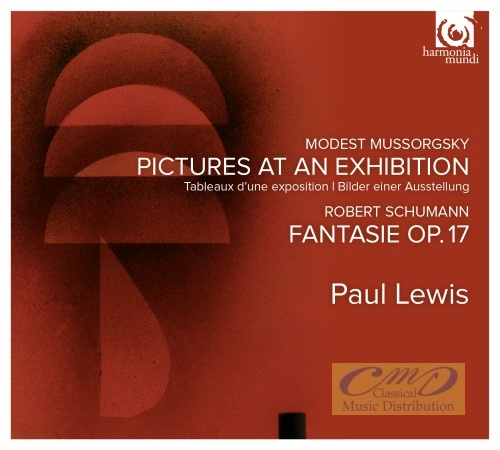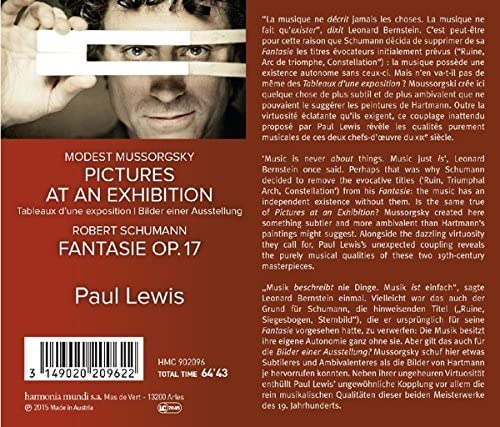
classical music distribution


(Produkt nie został jeszcze oceniony)
kompozytor
Mussorgsky, Modest;
Schumann, Robert
tytuł
Mussorgsky: Pictures at an Exhibition / Schumann: Fantasie
wykonawcy
Lewis, Paul
nr katalogowy
HMC 902096
opis
In 1870, the architect, sculptor and painter Viktor Hartmann (born in 1834) was invited by Vladimir Stasov, the most influential Russian art critic of his time, to join the ‘Group of Five’, a St Petersburg-based circle of composers that, in addition to Mussorgsky, included Borodin, Balakirev, Cui, and Rimsky-Korsakov. The members of this ‘Mighty Handful’ had set themselves the spiritual task of establishing a national Russian music free of western influences. Just three years later, in August 1873, Hartmann died of an aneurysm; he was not yet 40. ‘What misfortune! O greatly suffering Russian art!’ wrote the deeply affected Mussorgsky, lamenting the loss of his friend. Along with Stasov, he championed the cause of a memorial exhibition in honour of his intellectual fellow-spirit. Stimulated by this much-admired retrospective, in the spring of 1874, which presented some 400 pictures from different phases of the artist’s creative career, Mussorgsky decided to erect a musical monument to the dead man as well. He threw himself feverishly into the work. When the piano cycle was completed on 22 June 1874, the manuscript bore the inscription: ‘Dedicated to Vladimir Vasilievich Stasov. Pictures at an Exhibition. In Memory of Viktor Hartmann.’ Mussorgsky created here something subtler and more ambivalent than Hartmann’s paintings might suggest. Alongside the dazzling virtuosity they call for, Paul Lewis’s unexpected coupling reveals the purely musical qualities of these two 19th-century masterpieces.
nośnik
CD
gatunek
Muzyka klasyczna
producent
Harmonia Mundi
data wydania
25-11-2014
EAN / kod kreskowy
3149020209622

(Produkt nie został jeszcze oceniony)
cena 58,00 zł
lubProdukt dostępny.
Wysyłka w ciągu 3 dni roboczych
Darmowa wysyłka dla zamówień powyżej 300 zł!
Darmowy kurier dla zamówień powyżej 500 zł!
sprawdź koszty wysyłkiProduktu jeszcze nie zrecenzowano, chcesz być pierwszy?
Klienci, którzy kupili ten produkt, kupili również
Pozostałe płyty tego kompozytora
Mussorgsky, Modest, Schumann, Robert
WYCOFANY Mussorgsky: Tableaux d'une exposition, Schumann: Carnaval
MYR 013
Schumann, Robert, Bruckner, Anton
Vienna Philharmonic - Martha Argerich & Zubin Mehta
764508
różni kompozytorzy
National Theatre Belgrade - Seven great Russian Operas from 1955
PH 19040
Schumann, Robert
Schumann: Lieder - Gedichte der Königin Maria Stuart op. 135, Rückert-Lieder, Liederkreis op. 39
HMC 902031
różni kompozytorzy
Rachmaninov: Solo Piano Recordings 3 - Preludes, Etudes-Tableaux
8.111397
Pozostałe płyty tego wykonawcy
Schubert, Franz
Schubert: Piano Sonatas D. 840, 850 & 894, Impromptus D. 899, Klavierstücke D. 946
HMC 902115.16
Napisz recenzję dla: Mussorgsky: Pictures at an Exhibition / Schumann: Fantasie
Zapytaj o dostępność produktu
Twoje zapytanie:
Odpowiemy na adres:
Produkt został dodany do koszyka

Mussorgsky, Modest, Schumann, Robert
Mussorgsky: Pictures at an Exhibition / Schumann: Fantasie
1 szt












































